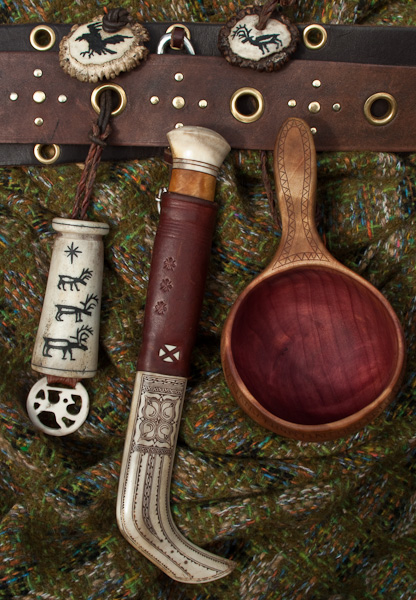Hello everyone,
I would like to reintroduce an elegant belt design that I believe was used by Ötzi the Iceman over 5000 years ago. It is a design that I hope you will consider integrating into your bushcraft kit as it is simple to make and extremely useful.
For those of you that are not familiar with Ötzi the Iceman, he was a natural mummy found in the Italian Alps in 1991 who lived during the early copper age. A study of the items he was carrying provides a fascinating example of bushcraft as a way of life, and I recommend that any bushcrafter spend some time studying his tools, equipment, and clothing.
The Icemans Belt
The Iceman's belt was a strip of leather that was long enough to pass around the waist twice, and was just over 6cm wide. On the front of the belt was a leather pouch that held some tinder fungus and some tools. This pouch and its contents have received a great deal of interest in the bushcraft community and beyond. Less discussed are the two strips of leather lacing (thongs) that are woven into the belt on the section opposite to this pouch. It is my belief that the Iceman used these thongs to attach items to his belt using toggles that he made from natural materials.
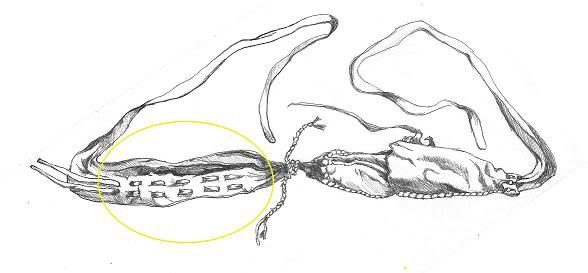
An artistic representation of the Iceman's Belt. Note the leather thong woven through it (highlighted section).
Among the items found with the Iceman was a small stone disc with 9 leather thongs attached, whose function has been described as unknown. Two walnut-sized pieces of Birch Polypore fungus (Piptoporus betulinis) attached to single leather thongs were also found. Bushcrafters may know of this useful fungus as the Birch Bracket or Razor Strop fungus. Various functions have been proposed for these three items, all of which are entirely plausible. I would also like to suggest that the Iceman used these items to attach game or other items to his belt in a very unique way.
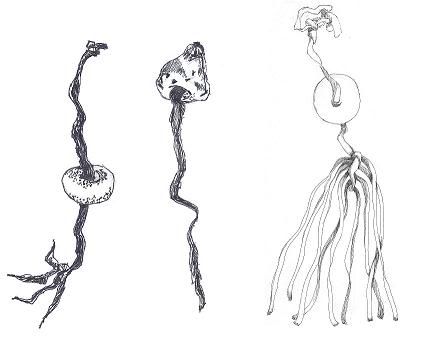
An artistic representation of three of the items found with the Iceman.
For those of you that have worked with the razor strop fungus, you will know that it is soft when wet and quite hard when it dries. It is similar to modelling clay in that it can be easily shaped when wet but can form a hard and functional item when dry. It is my belief that the Iceman was aware of this property. By using his flint knife to cut and shape the fungus when it was wet, and using a twig or other tool to poke a strip of leather through a hole, he could have easily made an item that looked something like this:

It is my belief that the pieces of birch polypore and the stone disc found with the Iceman formed toggles that he used to attach items to his belt. To test and illustrate this concept I have made my own version of the Iceman's belt. It lacks a pouch, but retains the two thongs in the form of a piece of paracord that I have simply woven into the belt after burning small holes.
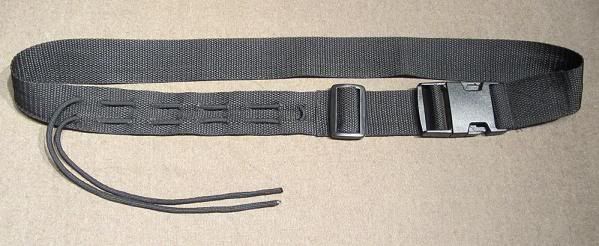
A modern version of the Iceman's belt.
Toggles can be made and attached to various items:
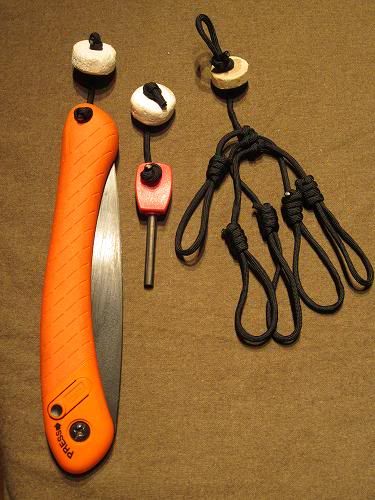
Items Attached to Fungus Toggles (Game harness at right)
How to Use the Iceman Belt
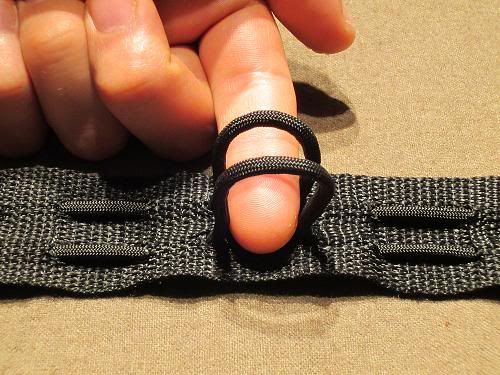
Step 1: Open the cordage to make loops.
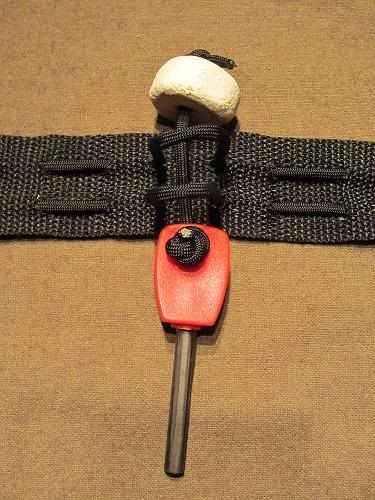
Step 2: Place the toggle through the loops.
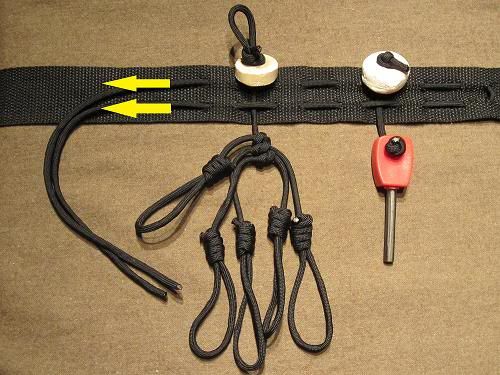
Step 3: Tighten the tag ends in the direction of the arrows to secure the item.
A knot such as a bow can be tied with the tag ends for extra security.
Here is a short video that shows the belt in action:
[video=youtube;wGYU9cADz_8]http://www.youtube.com/watch?v=wGYU9cADz_8[/video]
I have found this system extremely useful for carrying bushcraft tools and equipment. It is well suited for carrying items that you need to access frequently and want to carry securely. Many sheaths/cases come with belt loops, but it is inconvenient to have to remove your belt to attach them if you only plan on using the item for a short time. The loops in the belt can also be used to carry things like grasses, edible plants, and cordage fibers as you collect them.
This system is also well suited for carrying small game. When hunting it is necessary to cool game quickly after cleaning, and a carrying method is often employed until a base camp is reached. It is my belief that the stone disc and thongs carried by the Iceman was actually a harness used to carry birds. The system allows the harness to be removed, attached to game on the ground, and quickly reattached to the belt as required.
Make Your Own Iceman Belt
I highly recommend that you consider making your own Iceman Belt as it is very simple to do and you probably already have some of the materials in your home. It is a very lightweight system that works well with modern belt loops and can easily be added to a belt you may already be using.
A sturdy piece of 3.8cm (1.5 inch) wide nylon webbing with a webbing clip buckle makes a serviceable bushcraft belt. You will also need a nail that is slightly smaller than the diameter of cordage you are using, a candle, a pair of vice grips and some cordage.
Mark the spots for the pairs of holes about one finger width apart, and the two horizontal lines of holes a finger width apart. The number of holes can be suited to the user, just be sure not to make too many or you will not be able to access the ends of the cordage to tighten as they will be too far behind your back. Hold the nail in a pair of vice grips and heat it with a candle to burn in the holes. Try to do this in a well ventilated area and be careful not to burn yourself. The holes should end up being slightly larger than the diameter of the cordage you are using. After the holes are made, simply cut a piece of paracord to the correct length (about twice the length of the set of holes plus two hand lengths) and weave it through the holes as shown in the photo above. Other materials such as leather could easily be used to make this type of belt, and the use of eyelets would improve its durability.
To make the toggles, try to find a piece of razor strop fungus in your local forest. If that is not possible, other materials can be substituted. A section of sapling with a hole drilled in it works well. I think the stone disc that the Iceman used was actually a discarded spindle whorl, which is used to spin wool. So even he was improvising! If you happen to have dried razor strop fungus you can soak it in warm water to soften it. Using your knife (this fungus will dull your knife!), shape the fungus into a rough disc shape about two fingers wide and one finger deep. While it is still wet, poke a hole into the centre with a twig. Then push through your cordage and add a stopper knot of your choice. After the fungus dries and hardens you can sand it with stones or sandpaper to refine the shape of the disc.
Spare toggles can easily be made in the field or prior to your trip and attached to any items that you wish to carry with this system. If using the razor strop fungus, try to keep the toggles dry, as they will become soft when wet. It looks like the Iceman's belt had a flap of leather to protect the toggles from moisture. When carrying long items such as your saw or game, I recommend that you place the toggle on or near your hip bone on the front of the body. Items in this position tend to remain stationary when walking and do not flop around.
Detailed study of the Iceman's tools and equipment provides a fascinating glimpse into the roots of modern bushcraft. The unique belt design that he employed is no exception. I hope you will find this system useful on your next bushcraft outing. If you do decide to make and use it, you will be carrying a true marriage of past and present technologies which represents a core component of nearly all bushcraft teaching.
[Post Update: August 4, 2012]
The Iceman may have used his belt in a different position than I do. It is my feeling that he probably wore the section with the thongs through it on his left hip at the front, with the pouch on the left hip at the rear. This would have put the tag ends closer to the front for easy access. The part in between would have been a great place for his knife, and is also the position that many of us carry our knives in today. Thank you to brossa on BushcraftUSA for his comments on this.
I would like to reintroduce an elegant belt design that I believe was used by Ötzi the Iceman over 5000 years ago. It is a design that I hope you will consider integrating into your bushcraft kit as it is simple to make and extremely useful.
For those of you that are not familiar with Ötzi the Iceman, he was a natural mummy found in the Italian Alps in 1991 who lived during the early copper age. A study of the items he was carrying provides a fascinating example of bushcraft as a way of life, and I recommend that any bushcrafter spend some time studying his tools, equipment, and clothing.
The Icemans Belt
The Iceman's belt was a strip of leather that was long enough to pass around the waist twice, and was just over 6cm wide. On the front of the belt was a leather pouch that held some tinder fungus and some tools. This pouch and its contents have received a great deal of interest in the bushcraft community and beyond. Less discussed are the two strips of leather lacing (thongs) that are woven into the belt on the section opposite to this pouch. It is my belief that the Iceman used these thongs to attach items to his belt using toggles that he made from natural materials.

An artistic representation of the Iceman's Belt. Note the leather thong woven through it (highlighted section).
Among the items found with the Iceman was a small stone disc with 9 leather thongs attached, whose function has been described as unknown. Two walnut-sized pieces of Birch Polypore fungus (Piptoporus betulinis) attached to single leather thongs were also found. Bushcrafters may know of this useful fungus as the Birch Bracket or Razor Strop fungus. Various functions have been proposed for these three items, all of which are entirely plausible. I would also like to suggest that the Iceman used these items to attach game or other items to his belt in a very unique way.

An artistic representation of three of the items found with the Iceman.
For those of you that have worked with the razor strop fungus, you will know that it is soft when wet and quite hard when it dries. It is similar to modelling clay in that it can be easily shaped when wet but can form a hard and functional item when dry. It is my belief that the Iceman was aware of this property. By using his flint knife to cut and shape the fungus when it was wet, and using a twig or other tool to poke a strip of leather through a hole, he could have easily made an item that looked something like this:

It is my belief that the pieces of birch polypore and the stone disc found with the Iceman formed toggles that he used to attach items to his belt. To test and illustrate this concept I have made my own version of the Iceman's belt. It lacks a pouch, but retains the two thongs in the form of a piece of paracord that I have simply woven into the belt after burning small holes.

A modern version of the Iceman's belt.
Toggles can be made and attached to various items:

Items Attached to Fungus Toggles (Game harness at right)
How to Use the Iceman Belt

Step 1: Open the cordage to make loops.

Step 2: Place the toggle through the loops.

Step 3: Tighten the tag ends in the direction of the arrows to secure the item.
A knot such as a bow can be tied with the tag ends for extra security.
Here is a short video that shows the belt in action:
[video=youtube;wGYU9cADz_8]http://www.youtube.com/watch?v=wGYU9cADz_8[/video]
I have found this system extremely useful for carrying bushcraft tools and equipment. It is well suited for carrying items that you need to access frequently and want to carry securely. Many sheaths/cases come with belt loops, but it is inconvenient to have to remove your belt to attach them if you only plan on using the item for a short time. The loops in the belt can also be used to carry things like grasses, edible plants, and cordage fibers as you collect them.
This system is also well suited for carrying small game. When hunting it is necessary to cool game quickly after cleaning, and a carrying method is often employed until a base camp is reached. It is my belief that the stone disc and thongs carried by the Iceman was actually a harness used to carry birds. The system allows the harness to be removed, attached to game on the ground, and quickly reattached to the belt as required.
Make Your Own Iceman Belt
I highly recommend that you consider making your own Iceman Belt as it is very simple to do and you probably already have some of the materials in your home. It is a very lightweight system that works well with modern belt loops and can easily be added to a belt you may already be using.
A sturdy piece of 3.8cm (1.5 inch) wide nylon webbing with a webbing clip buckle makes a serviceable bushcraft belt. You will also need a nail that is slightly smaller than the diameter of cordage you are using, a candle, a pair of vice grips and some cordage.
Mark the spots for the pairs of holes about one finger width apart, and the two horizontal lines of holes a finger width apart. The number of holes can be suited to the user, just be sure not to make too many or you will not be able to access the ends of the cordage to tighten as they will be too far behind your back. Hold the nail in a pair of vice grips and heat it with a candle to burn in the holes. Try to do this in a well ventilated area and be careful not to burn yourself. The holes should end up being slightly larger than the diameter of the cordage you are using. After the holes are made, simply cut a piece of paracord to the correct length (about twice the length of the set of holes plus two hand lengths) and weave it through the holes as shown in the photo above. Other materials such as leather could easily be used to make this type of belt, and the use of eyelets would improve its durability.
To make the toggles, try to find a piece of razor strop fungus in your local forest. If that is not possible, other materials can be substituted. A section of sapling with a hole drilled in it works well. I think the stone disc that the Iceman used was actually a discarded spindle whorl, which is used to spin wool. So even he was improvising! If you happen to have dried razor strop fungus you can soak it in warm water to soften it. Using your knife (this fungus will dull your knife!), shape the fungus into a rough disc shape about two fingers wide and one finger deep. While it is still wet, poke a hole into the centre with a twig. Then push through your cordage and add a stopper knot of your choice. After the fungus dries and hardens you can sand it with stones or sandpaper to refine the shape of the disc.
Spare toggles can easily be made in the field or prior to your trip and attached to any items that you wish to carry with this system. If using the razor strop fungus, try to keep the toggles dry, as they will become soft when wet. It looks like the Iceman's belt had a flap of leather to protect the toggles from moisture. When carrying long items such as your saw or game, I recommend that you place the toggle on or near your hip bone on the front of the body. Items in this position tend to remain stationary when walking and do not flop around.
Detailed study of the Iceman's tools and equipment provides a fascinating glimpse into the roots of modern bushcraft. The unique belt design that he employed is no exception. I hope you will find this system useful on your next bushcraft outing. If you do decide to make and use it, you will be carrying a true marriage of past and present technologies which represents a core component of nearly all bushcraft teaching.
[Post Update: August 4, 2012]
The Iceman may have used his belt in a different position than I do. It is my feeling that he probably wore the section with the thongs through it on his left hip at the front, with the pouch on the left hip at the rear. This would have put the tag ends closer to the front for easy access. The part in between would have been a great place for his knife, and is also the position that many of us carry our knives in today. Thank you to brossa on BushcraftUSA for his comments on this.
Last edited:

